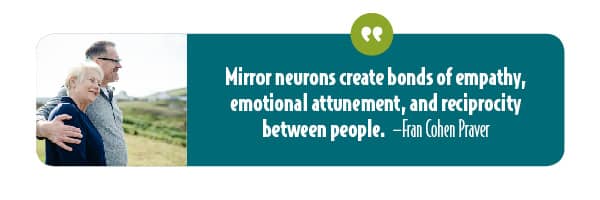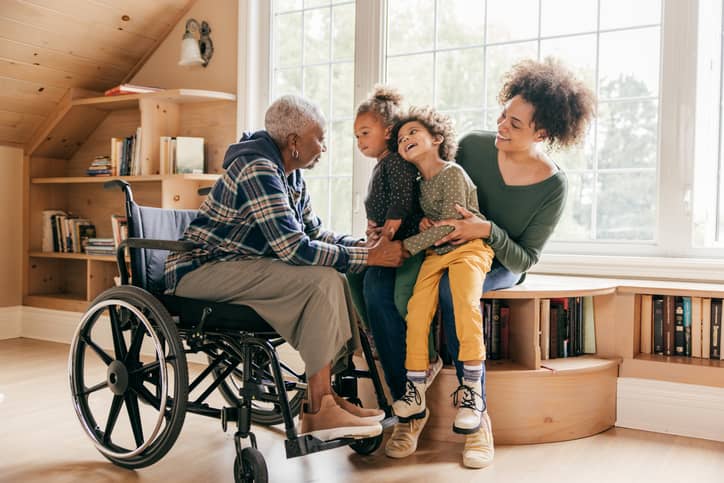Empathy is embedded in the deepest parts of our brain and affects every relationship. From the first time that we shared our snack on the playground, to helping a friend study for a college exam, to supporting our spouse during a hectic work cycle, the opportunities are endless for this vital emotional intelligence skill. And it’s an indispensable part of being human, an emotional conduit for human connection and better relationships!
Estimated reading time: 6 minutes
 In a world that often emphasizes individualism and self-interest, cultivating empathy is crucial for fostering compassionate and interconnected relationships and society. By recognizing and valuing the feelings of others, we can forge meaningful connections and contribute to a more caring world. Through empathy, we experience a profound sense of shared humanity and the transformative power of emotional connection.
In a world that often emphasizes individualism and self-interest, cultivating empathy is crucial for fostering compassionate and interconnected relationships and society. By recognizing and valuing the feelings of others, we can forge meaningful connections and contribute to a more caring world. Through empathy, we experience a profound sense of shared humanity and the transformative power of emotional connection.
Before we explore the study of empathy, let's identify a definition so we're on the same page.
Define Empathy: What Does It Mean to Be Empathetic?
In its simplest form, a definition of empathy means that we sense someone else’s emotions and see the world through their eyes. Empathizing is linking with another person’s experience through understanding.
In an effort to understand someone, we open ourselves to connect. When empathy is present in any relationship, including a romantic one, people are joined. Empathy creates a resonance with other people when we are able to hone our attunement, communication, and listening skills. This coherence between two people is called emotional resonance.
Empathy promotes unity and allows us to connect in real time, closing the gap of differences and dissolving tension and stress in relationships. It involves putting a spotlight on someone else’s feelings while dimming our own. Empathy is crucial to healthy relationships. To effectively empathize, you must be prepared for the impact that comes with being fully present.
Additionally, empathy is also a great way to foster compassion and kindness within us. It encourages us to empathize with others, not only with loved ones but also with strangers and even those with whom we may have differences. To be able to understand where someone is coming from is vital in all communication.
The Agility of Empathy and Empathizing
The beauty of empathy lies in its versatility. It can be applied in any context, from consoling a grieving friend to celebrating someone's success with genuine enthusiasm. By putting ourselves in another person's shoes, we create a deep emotional connection that transcends superficial interactions. Without empathy, we fail to understand what others are feeling or how our loved ones interact with their experiences and challenges.
Empathy serves as a vital component of emotional intelligence. It enables us to perceive and understand the emotions of those around us, ultimately strengthening our bonds with others. By recognizing and empathizing with their experiences, we validate their emotions and demonstrate our care and understanding. However, there’s so much more to empathy than feelings.
The 3 Types of Empathy
What people tend to forget is that empathy can be expressed differently and is often categorized into multiple types. Empathy is not a singular, ‘one size fits all’ ability. It varies from person to person and situation to situation.
HOW you empathize will depend on the specific relationship, the person, the history of your relationship, their relationship with themselves, and the situation. Our emotional responses can even be varied and tailored to different personalities. Utilizing the different forms of empathy will assist you to know the basics.
With this in mind, here are the three different types of empathy:
- Emotional Empathy;
- Cognitive Empathy; and
- Compassionate Empathy.
Let’s begin with the most commonly recognized form of empathy: Emotional Empathy.
Emotional Empathy (or Emotional Resonance)
Emotional empathy involves feeling the emotions of others and sensing a whole range of emotional terrain for what someone else feels. If the sight of your partner’s joy or misery ignites that same feeling inside of you, then you are empathizing emotionally.
A great example of emotional empathy comes from watching babies. If a baby sees or hears another baby crying, they often start crying, too. This is the most elementary display of the mirror neurons doing their job.

Although adults monitor and regulate their emotions better than infants, they can also share feelings in the same way. For example, at a wedding, have you ever noticed how contagious the joyous emotions are? It is commonplace for people to cry or have a smile plastered on their face throughout the ceremony—unless of course, the guests are preoccupied with their own internal struggles or grief. Empathy helps connect us to others in meaningful ways without judgment or bias.
Cognitive Empathy
Cognitive empathy involves a greater focus on thoughts and logic, basing one’s response on perception and memories that give meaning to another person’s experience. Cognitive empathy is the ability to use logic to understand how others' thoughts and feelings or what they may need.
A great example of cognitive empathy is how therapists may talk to their patients. Their session might involve quietly and compassionately listening as the client speaks, sharing words of encouragement, and asking follow-up questions in an effort to better understand them. This type of empathy provides information to support and prioritizes logical thinking and understanding.
Compassionate Empathy
Compassionate Empathy is interchangeable with compassion. What sets it apart from other types of empathy is its action and engagement factor. This type of empathy occurs when you understand what someone is going through and have an empathic concern for them. You feel compelled to act on their behalf.
For instance, if a friend is frustrated or worried because they're facing a big move with a tight timeline. They're stressed in their apartment search because as soon as they inquire, they find out the space has already been rented. In this situation, you are likely to feel empathy and be concerned. You may choose to show your support by pitching in with the search and asking around on their behalf. And you might also offer them your spare room until they find a new place to ease the pressure. Taking action sets this variant of empathy apart from emotional and cognitive empathy.
Steps of Compassion
- You feel the pain or struggle of another.
- You consider what you can do to help the person.
- You take action to ease or alleviate the person’s pain.
Deep Dive: "The Three Kinds of Empathy: Emotional, Cognitive, and Compassionate."
How to Develop Empathy and Emotional Intelligence
With these three forms of empathy in mind, let’s look at the ways you can develop empathy and learn how to empathize effectively. If you are thinking that you have a hard time empathizing or you've been told that you lack empathy, be encouraged. The ability to understand as well as the ability to feel is inside us all. And fortunately, it is a skill that can be learned. These simple steps will help you. And remember, empathy doesn't mean you get emotional but rather it's about putting yourself in someone else's shoes.
Below are some ways (or mini-steps) for learning to empathize. We’ll go into more depth in each one later.
- Prioritize active listening in your everyday encounters.
- Observe body language cues.
- Protect important conversations from distractions.
- Make empathetic apologies.
- Follow up on previous conversations.
Let's begin exploring the first step of creating more compassion for those around you.
Emotional Intelligence Skills for Everyday Empathy!
#1 Prioritize active listening in your everyday encounters.
In our day-to-day lives, active listening is rare because our attention is often so divided. We’re receiving messages and emails on our Apply watches, we’re checking texts on our phones—and technology, in general, is lowering our attention spans.
Yet, active (or attentive) listening is one of the easiest ways to practice empathy. To better understand what active listening may look like, consider this: the difference between hearing and listening.
Hearing is the act of passively absorbing sound. Listening, however, implies that we are paying attention to the person’s expressions and emotional tenure, the words, and the context of what is spoken. That could involve taking mental notes and capturing key words they use, such as “frustrated” or “sad.”
Simply put, active listening is making a conscious effort to concentrate entirely on the speaker.
One of the goals of all of the different kinds of empathy is to help the person feel as if their experiences are shared and their perspective and feelings are heard and validated, regardless of whether you agree with them or not.
Sometimes it can be as simple as being fully present and mirroring the person. You can also make eye contact while interjecting affirming responses, e.g., “sounds like you feel …” These are simple ways to hone your empathic listening skills.
#2 Observe body language cues.
Some conversations start before anyone has uttered a word. Whether you realized it or not, during any encounter, we are watching the person's facial expressions and demeanor.
Body language cues are nonverbal signs that can reveal unspoken feelings. One of the telltale signs that someone’s nervous, for example, is fidgeting. Or they may avoid eye contact, fold their arms in a defensive posture, and act like they want to be somewhere else. Or the person might interrupt you for no apparent reason. If their gaze is downward, and the person sighs heavily, they may be sad.
On the contrary, if a person is relaxed and engaged, it’s a sign that they’re interested. When they make eye contact, you are able to connect differently. Or perhaps they have a buoyant energy about them; perhaps, they are happy about something in their life that you can inquire about.
So how can we use body language cues to better empathize?
Empathy is the ability to "read" people. For instance, if your partner, who usually has a warm disposition in the mornings appears cranky, take it as a hint that something might be bothering them. You don’t need to wait for them to bring up the topic on their mind when you pay keen attention to their body language. You can mirror what your seeing and inquire gently.
Or perhaps, your preschooler or teen comes home from school wearing a long face. You ask what’s wrong and they say, "nothing." Many parents will take their answer at face value. However, empathy can help in this situation. You could say, “Hmm. You said nothing, but your sad face says otherwise. Are you feeling down about something?”
Empathy IS understanding, the ability to SEE the perspective of others, NOTICE the suffering of others, and UNDERSTAND why they feel how they do. Empathy leads to increased connection and promotes greater connectivity.
 Empathy is a skill that helps a person (or child) feel heard and understood. The ability to empathize requires we pay attention to others' emotional state. Whether they need a listening ear or some sound advice, capitalize on observing the cues in the people in your life. And ensure that your own body language is inviting, too. Consider smiling, nodding occasionally, and maintaining eye contact!
Empathy is a skill that helps a person (or child) feel heard and understood. The ability to empathize requires we pay attention to others' emotional state. Whether they need a listening ear or some sound advice, capitalize on observing the cues in the people in your life. And ensure that your own body language is inviting, too. Consider smiling, nodding occasionally, and maintaining eye contact!
#3 Protect important conversations from distractions.
Some conversations can compete with the sounds of TV, traffic, and chatter blaring in the background. Others can’t. It is important to differentiate between the two. Knowing when privacy and a quiet environment are crucial is foundational to empathizing.
While you can have small talk inside a loaded elevator, the same surroundings wouldn’t be ideal for a heartfelt conversation. It’s likely someone could overhear, which can create hesitancy in sharing and even a lack of safety for a deeper or more difficult conversation. This may seem so basic; however, it is a key ingredient of being attuned and one that is often overlooked.
#4 Practice empathetic apologies.
Apologizing is a mature way to show someone that you respect them.
Many times, the last thing you set out to do was offend or upset someone, but that doesn’t erase what you said or did that invoked a reaction.
Apologizing implies that you understand how your words and actions have impacted someone else. That is exactly what empathy entails: Understanding feelings outside of your own!
A genuine apology is harder, but far more rewarding.
Let’s say your best friend, Maria, had an important presentation for a big event. She not only made a special request for you to be there to support her but also mentioned several times how important this event was to her career—and how much work she put into it!
Through some poor scheduling on your part, you arrive late to the event—after her speech! Rightfully so, Maria is upset and hurt.
What many people try to do is explain away why they made the misstep. Don’t.
Or they try to justify their behavior. For example, using the above scenario, the friend could say something like, “I knew you'd knock it out of the park and really didn’t need my support.” Don’t justify.
And a simple “I’m sorry” doesn’t begin to adequately address Maria’s hurt feelings either. Time to pull out the empathetic apology. Here’s an example:
“Maria, I totally blew it and let you down! You asked for me to be there and I knew how important that presentation was to you. Yet, I still didn’t make it a priority to leave early enough to be on time. You have a right to be upset with me. Please forgive me.”
It is important to remember that real empathy is not scripted. An apology can only sound as genuine as you feel, so be sure to be upfront about what you’re apologizing for.
To learn the 4 key steps, read "Empathy and the Empathetic Apology: The New Improved 'I'm Sorry!'"
#5 Follow up on previous conversations.
While compassionate empathy is ideal, cognitive empathy has its perks. That includes its focus on logical thinking, understanding, and recalling what was said. At its core, cognitive empathy is recognizing someone else’s experiences.
Therefore, empathy can also be expressed by following up on past conversations. This follow-up is a great way to bring empathy into your relationships!
It’s no surprise that we all want to feel as though we’re being heard—it’s a human need. And even more so when we are vulnerable with someone. However, being listened to is NOT the same as truly being heard. As we mentioned before, active listeners take mental notes of what has been said.
If a friend of yours has been working tirelessly towards healthy eating, for example, find a way to casually bring it up in conversation and ask how they’re doing on their goal. Here are a few ways to work it in:
- Check in periodically on their journey so far.
- Gift your friend a cookbook of gluten-free recipes with a kind note written inside.
- Encourage them to keep going with affirmative words.
- Ask them for pointers or suggestions that would be useful to you.
- Empathize with just how hard it can be to stick to a lifestyle diet.
What may have felt like mindless rambling to them can serve to highlight that you were genuinely listening. And it showcases that you are interested in their goals.
You’ve already developed a genuine interest; showing you care about their progress is another expression of empathy.
Another way you could value them more is by being their accountability buddy—if they’d appreciate the comradery! Some people pride themselves in meeting their goals all by themselves.
Lacking empathy in any relationship can create unnecessary tension or misunderstanding. Therefore, it's also helpful to know the difference between sympathy and empathy; many people mistake sympathy for empathy. Don't make that mistake.
We can learn how to be more empathetic when we decide to fully embrace empathy. We can do this by first acknowledging how vital it is to have compassion in our relationships. Without it, we may never be able to relate to our friends, family, or partner on a deeper level.
Empathy can be learned! And it requires being practiced and mastered to work its magic. You’ve come this far, that is commendable! Keep it going through a mindfulness practice utilizing some of the tips above. With empathy skills, you can better connect with and understand those around you.
Hopefully, you understand now why empathy is important and how empathy for others can promote closer relationships.
If you'd like to increase your empathy and practice to reinforce what you’re learning, check out: Real Empathy, Real Solutions Self-Coaching Practice.
These simple exercises and practical tidbits give you the fundamentals on how to be more empathetic, along with an actionable plan that you can apply to real-life situations!
And the Heartmanity team is an email away from offering you customized, one-on-one coaching support! Feel free to reach out to us at support@heartmanity.com










